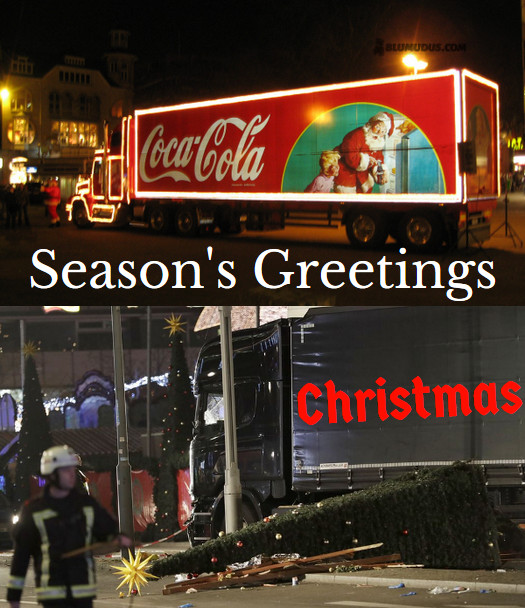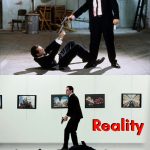
Looking back at the recent holidays, reflecting on their meaning
Contrasts
Nowadays even wars are fought through the power of images. ISIS edits a glossy magazine where appallingly cruel actions get a polished professional presentation worthy of the National Geographic. Terrorists are recruited through internet forums, where propaganda movies are the basic staple of an exciting diet of strong imagery for the bloodlusty aspiring jihadist: think of the executions, where the hostages have been worn down through endless dry runs, so that they pose no resistance and appear completely subjugated to their murderers.
Attacking Christmas is a natural choice for its symbolic value. Attacking a Christmas Market is even more incisive, because the shock effect is channeled through the shamefully/shamelessly most significant aspect of this Westerners’ Collective Holiday (shopping instead of prayers).
That’s why I decided to open with this stark contrast, between
A. a festive Coca Cola ad truck, representing a vague feel-good commercial holiday (modern imagery that lost any discernible relationship with Jesus, substituted by a red and white old man)
and B. a photo from the scene of the Berlin Christmas Market massacre, where the black truck violently rips into a la la land made up of plastic trees, warm lights and twinkling stars, shattering it with the inexplicable thrust of a ugly, crude, disgusting reality.
Come to think of it, Christmas represents the birth of a victim. Jesus Christ is the persecuted sufferer, always on the side of the murdered innocents.
A visual paradox. Which one of the two is the authentic Christmas?
They target our reassuring ephemeral icons. We are already conditioned: the New Year’s Eve terrorist attack to a Istanbul discotheque is a prime example. The first few reportages mentioned a gunman disguised with a Santa Claus costume. It wasn’t true, but it was easy for the media to spread such image.
The Berlin Breitscheidplatz attack. Fake news here too.
As most of you know, on December 19 in Berlin a truck was used to mow down people at a Christmas Market, killing 12.
It’s become immediately clear that the intent of the act was to hit “Christians”, the culprit being some Islamic fanatic terrorist.
Here’s a reasonable reconstruction. But watch out, it’s the wrong one!
The truck was already hitting the stalls of the street market, yet somehow it swerved away at the last moment. The position you can verify for yourself in the photos, where it’s clearly pointing toward the middle of the road, doesn’t seem compatible with the intent to inflict the maximum amount of harm.
Here’s what the journalists rushed to report: first of all the terrorist assaulted Lukasz Urban, the Polish truck driver, using a knife; that’s how he gained control of the vehicle. He didn’t use a gun in order to avoid making excessive noise. Convinced his victim was already dead, he drove the truck to the square of the market. But just when the murderous plan was being carried out, evidently Urban came around and, despite his injuries, managed to struggle with the murderer, swerving the steering wheel and the vehicle away from the pedestrians, limiting the damage. That’s when the terrorist killed him with a gun, then jumped out of the truck and successfully ran away.
This recollection was instrumental, in the aftermath of such a tragic and shocking event, to give the public something positive to chew on: an ill-starred hero, a humble truck driver that dies fighting for good. (In fact a petition was started to award a posthumous German medal of honor to the poor guy.)
But the attack occurred after 8 p.m., and the autopsy determined he died between 4.30 and 5.30 p.m…. This story is just a fantasy. A false explanation that most people will remember as true (and they can still find it on Google).
As it has been determined later, the truck stopped because there’s an automatic emergency braking system that is activated after an impact is detected. It seems the attacker tried to get back on the road and flee, since the vehicle was losing momentum. That’s when it came to a full stop, forcing him to run away on foot.
Of course Urban fought for his life, but this happened a few hours before.
And the prize for the most idiotic article goes to… the English newspaper The Mirror! They managed to build a politically correct nonsense interpretation of this story: since the terrorist Amri (as we’ll see) entered the EU as a refugee, but he didn’t qualify for the protection since he came from Tunisia, nobody could be blamed for his being able to roam around Europe freely, despite his prior crimes and being put under police surveillance! At best you could criticize the Tunisian Government that refused to take him back…
But, and here’s the ludicrous part, had Germany in the past closed its border, according to the Mirror geniuses there wouldn’t have been a Polish driver, Urban, fighting with the terrorist to try and save some of the victims!
Facepalm.
The proverbially dependable Germans fumble big time.
Initially the German police identified and captured a Pakistani suspect as the culprit. Afterwards it was revealed that they found on the truck the documents and fingerprints of Anis Amri, a Tunisian with a criminal record at home, who had been incarcerated for 4 years in Italy, receiving useless formal expulsion orders both from Italy and from Germany; known for his connections with Islamic extremists and for having used multiple fake identities, he had committed various crimes in Germany too (drug pushing, getting into fights).
Most European police forces, plus at least Morocco and Tunisia, knew or had the opportunity to know about the danger he posed. And yet he was able to move around freely, even after the attack, probably getting through the Netherlands, then by coach to France (Lyon, Chambery) then by train reaching Torino via the small town of Bardonecchia. Eventually getting to Milan and the small nearing town of Sesto San Giovanni, where he was intercepted and killed by a random Italian police patrol reacting to his firing first, while there had been no advances in the investigation in the meantime.
Doubts.
It’s an inevitable question: how come a terrorist ends up losing his wallet, containing his documents, under the seat of the truck he’s using to perform an attack?
Stranger things happen. But this isn’t the first occasion where the culprit in a terror act is revealed this way. It happened with the Charlie Hebdo attack too.
Moreover, why did the German police initially accuse another guy? Weren’t they supposed to search and dust for fingerprints immediately, instead of wasting away an entire day on a wrong lead?
There are many puzzling details here.
You end up asking yourself: how can we trust sources? How could we decide where the truth lies?
As we’ll see in further articles, news sources have become (become?) really unreliable. But even when there’s no bias or foul play involved, the complexity of issues and the superficial approach by journalists guarantee that you’ll face many unsolvable conundrums.
The problem of terrorism in general deserves a separate discussion.
But it’s also worth the effort, and instructive, to try and study the details of a specific case.
Inconsistencies. You can find some in any event, they don’t prove anything.
As for the unexpected retrieval of the documents, there are many possible explanations. In this case we can exclude the theory of his “losing” a document as a way of claiming credit for the attack. Clearly Amri tries to flee across Europe, he’s really not in the mood of getting caught.
My best guess would be that this is one of the instances where the typical mentality of certain cops shines through the story: lacking subtlety, they came up with such an incredible turn of events to cover for the real source: perhaps some informer they didn’t want to expose. I’m not saying that’s definitely it. Maybe Amri did lose the wallet!
Here’s my point: a situation could be complex and full of surprises, without the need of a conspiracy behind it all. And the most logical explanation isn’t necessarily the correct one.
Yet, presuming coincidences, human stupidity and mistakes goes a long way, certainly more than imagining Machiavellian plans.
They were late in reporting the fingerprints, disorganized in trying to stop him: this just proves the lack of efficacy and coordination of the European police forces, nothing more.
We could argue at length, though, about how the European laws and judges seem to be dead set, by design, on facilitating suspects that appear potentially very dangerous; excusing them, releasing them, letting them decide if they want to comply without fearing actual consequences.
Let’s examine some other curious aspects of the story. Here’s a couple of articles I used as sources; the first one, in Italian from Corriere della Sera, is helpful to pinpoint the whereabouts of the truck. Another more thorough recostruction can be found on the Daily Telegraph.
In 2010 Amri was accused of stealing a truck in Tunisia. Could we really believe he was innocent of that crime, that this was just a coincidence? I don’t think so.
Therefore our subject was a truck thief, at least occasionally, who chose a truck to commit a mass murder: he had to be familiar with truck driving! And yet, according to the Corriere article and many others, 4 hours before the attack,
as evidenced through GPS traces, the truck is involved in odd maneuvers. It goes back and forth, the engine suddenly stops and is restarted again: «As if someone were learning to drive it»
How come at this point the driver was ‘choking’ the engine, as reported? A truck thief acting suspiciously, moving the truck as if he were inexperienced and trying to get used to the vehicle, 10 Km away from the target in the center of a metropolis, possibly with a mortally wound driver on the adjacent seat, with blood everywhere… Then he stops the lorry, kills the driver with a gun and waits in place for another 3 hours… A really unlikely turn of events, you’d say.
According to this article Amri tried to get his hands on high caliber rifles last March, preparing for some attack. And yet… he got to his appointment with death with a small .22 gun, a really unimpressive weapon of limited lethality. :-O
The investigations revealed he had an extensive network of contacts in Germany and Italy. He lived in Rome and in Aprilia (just south of Rome) in 2015, after he was released from prison.
It seems implausible that he devised such a shaky and improvised plan, managed to escape anyway, then he tried very hard to avoid capture, fleeing across half of Europe, instead of acquiring some and/or trying to become a “martyr”, as we have seen in prior terrorist attacks, where even those who managed to escape took the opportunity to attack a second target elsewhere, knowing it would be futile to hope to get away in such cases.
Why didn’t he at least try to secure a safe hiding place, getting in touch with some of his friends from prison beforehand? He died without a cell phone. He lost his wallet on the truck! The very same individual that had been under surveillance by multiple police forces, who had used at least 6 fake identities with forged documents, is suddenly running across the continent without means. And the documents he left on the crime scene are his original ones, revealing his true identity…
On his body they found a Dutch phone SIM: why acquiring it, if he didn’t try to hide there? Then he went to France. Then, as he got to Italy, he stopped for more than 2 hours in Turin central station, as if waiting for someone who didn’t come. He was recorded by surveillance cameras in Milan central station, then he got to the nearing Sesto San Giovanni, where he was killed.
Of course, there are good reasons to choose trip destinations like Chambery, Bardonecchia and Sesto San Giovanni, small towns where you don’t expect to find international travelers. Journalists suggested that in Sesto he was going to take a long distance coach, possibly to Eastern Europe. Others pointed to the town of Bergamo, still in the region. Or Aprilia again, south of Rome. And yet his dying in that small town represents a curious coincidence.
The most improbable detail.
AFAIK this bit didn’t get much publicity, but the square where Amri was killed on December 23 is surprisingly close to the street where Urban’s truck departed on the 16.
As you can see from the following map, the grey and red marks are within walking distance. Yet, the massacre happened more than 1000 Km from there!

Life is strange. After such Europe Grand Tour across multiple countries, Amri goes to die in the same area from which the truck departed!
I marked the map indicating 3 other places, mosques in Sesto San Giovanni, that may help us understand the context of this small town.
Obviously I’m not saying there’s a connection between the local mosque (or the imams) and terrorism. I’m not accusing anyone.
The mosque to the south of the map was actually used a few years ago. Then there’s a site that has been identified as the location of a planned mega-mosque. Further north, in a somewhat isolated area on the outskirts, we can find a temporary mosque, the one in use today; this mosque happens to be very close to the factory from which the truck departed after being loaded.
The fate of Sesto San Giovanni…
This small town is known for its historic blue collar identity: one of the most ideologically militant strongholds of communism of the entire northern Italy.
There’s a stark contrast with the nearing Milan, the economic capital of Italy, where you could find an unusual concentration of business-oriented types, a former Berlusconi constituency.
After all, where did such attitude, proudly siding with the proletariat (against the evil Capital) lead? It’s been rendered obsolete by history. With the decline of industry.
Sesto is becoming the town sporting the biggest Islamic community of Milan’s hinterland. Although numbers are still low: Muslims represent about 6% of the population.
Consider the irony. Right in front of a city park entitled to Antonio Gramsci, the ideologue inspiring the diabolical (and effective!) leftist strategy to take control of the entire society through a monopoly occupation of the media, schools and universities, they’ll build the biggest mosque of the region. This certifies the utter, complete failure of Gramsci’s idea: you can destroy your enemies by poisoning the wells of culture, but this action created a void, a society without values or hopes; your destiny becomes being colonized by some external force.
So… Islamism then.
Bear in mind: in this region there’s no clearly visible support for terrorism or even public displays of extremism. According to some observers, there’s fire smoldering under the surface.
Take the following with a grain of salt: I don’t know how to verify this information and I have no control about possible media misrepresentations that try to stretch the truth. In the Lombardy region, close to Milan, it seems there’s a significant concentration of Islamic extremists, but they used to bring their fight elsewhere, first and foremost to Syria. Only recently they were allegedly ordered to attack Italy too. A few terror plots have been already foiled by Italian anti-terror police groups.
There’s an old story thrown around regarding Italian secret services, probably limited to pre-9/11 Islamic Extremists. Italian politicians allegedly had a secret deal with (some of) those groups:
-you guarantee there will be no incidents or terrorist-linked deaths on Italian soil; in exchange we will close an eye on your activities…
So, in conclusion… Is Italy -for now- a safe place where a terrorist could hide, and is this scenario meant to radically change in the near future?
The temporary mosque indicated on the map is said to be connected to the Muslim Brotherhood: a seemingly respectable organization, actually determined to impose Sharia law on the entire world. As you may know, this Islamic law happens to be for any self-respecting westerner. But, crucially, this movement chose long ago to use only peaceful means to reach global domination. That’s why this mosque’s leaders should not be directly linked to terrorism.
Of course some others, among those attending the same mosque, technically could.
But there’s another mosque further to the northwest of point 2, it’s just a 1.8Km walk away (a tad more than a mile): the Centro Islamico of Cinisello Balsamo, allegedly one of the most radicalized in Italy (again, I can’t verify this piece of information).
What we know beyond any reasonable doubt is that Urban, the truck driver, was a victim. He couldn’t conceivably have helped Islamists in any possible way; you’d actually have expected him to act more suspicious, staying away from any North African strangers on the road. And yet he was killed in his truck cabin, by someone he let in…
Here’s how I would reconstruct the events if this were a crime novel
There’s one more character in this story: a young North African Muslim who’s been radicalized and lives in Sesto San Giovanni, let’s call him Omar.
Early in the morning of December 16, a Friday (the holy day of the week in Islam), he went to the mosque to pray before leaving for his mission. He was set on performing a terrorist attack. Unknown to police and above suspicion, he was also pretty inexperienced. Someone instructed him a while back, suggesting an attack outside of Italy. Maybe in Germany. He wanted to create an impactful shock, ideally on Christmas Day.
Omar comes out of the mosque; maybe he’s improvising his plan and he’s still uncertain on how to get to the destination. After a few minutes he spots Urban’s truck that is ready to depart.
He asks the driver for a lift. This truck is going to Berlin! That’s just perfect; Omar thinks this is a sign from Allah: “Me too Berlin!”
Lukasz Urban naively accepts this unusual travel companion.
That’s how they both get to the German Capital city.
During the trip Omar takes advantage of a stop to contact someone who’s already in Berlin and could help him put his idea into effect. A mutual friend directed him to Anis Amri.
Maybe this was part of the original idea; at any rate, a decision is made to use that massive truck to mow down people at the Christmas Market. Omar has cold feet and hesitates, Amri takes matters into his own hands.
Let’s say that Omar injures Urban with the knife and Amri finishes him off with his gun.
But there’s still a problem: Omar doesn’t know how to drive a heavy truck. Amri tries to teach him, but it’s clear the guy couldn’t measure up. Too nervous, he couldn’t even keep the engine from shutting off…
Amri decides to take it from there. He’ll do it then. Even if it’s not his plan and he wasn’t properly prepared. He doesn’t want to die that day. His dream is dying doing something bigger, fighting like a soldier.
There’s no turning back. He sends Omar away, insulting him as a good-for-nothing coward.
He performs the evil attack and flees.
Eventually it’s his trying to find shelter (and possibly new forged documents) with mutual friends in Italy that causes his demise. He’s killed not far from Omar’s residence…
I’m not even convincing myself.
Too tortuous.
Even if it would explain this peculiar terrorist that tries everything to save his life, who happens to be quite disorganized notwithstanding his personal record: he used fake documents often, but he didn’t do so precisely in this occasion. It would partially explain the strange coincidence of Sesto, and more importantly the unexplained truck telemetry (inexperienced driver).
See, a smart move for some would be to try to sell this story as a sensational scoop, adding some fabricated evidence (protecting it through the use of a mysterious anonymous source) to support it…
It’s not that difficult to create a fake piece of news.
Ok, there are some details that don’t seem to add up, but my reconstruction isn’t credible enough. It’s just a wild speculation.
Beyond the reconstruction, though, let’s never forget that this event is first and foremost a dramatic, senseless and unacceptable act; its evil nature is even more excruciatingly evident if we try to put ourselves in the shoes of the victims and their relatives.
Life is surprising. Complicated.
Never fall in love with your guesswork!
Truth is hard. Elusive. Usually banal.










































